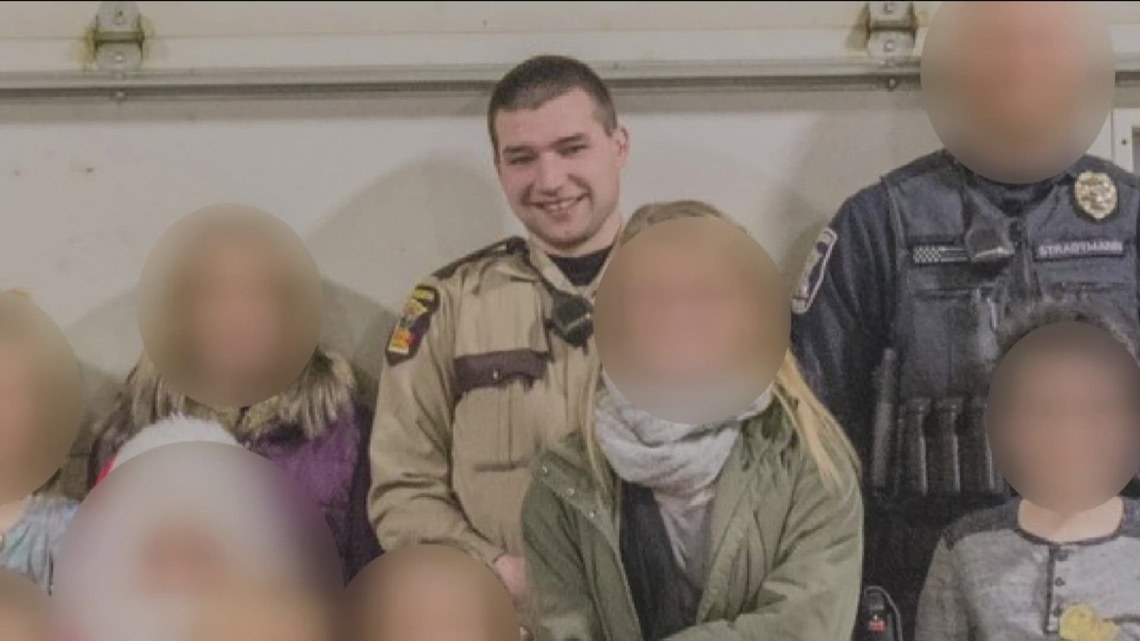Star Tribune
Suspect charged in murder on St. Paul’s West Side

A suspect in last month’s shooting death of 23-year-old David Lashawn Isaac on St. Paul’s West Side has been arrested and charged.
Justice Glaspie, 20, was charged with second-degree murder Friday by the Ramsey County Attorney’s Office, a day after his arrest in West St. Paul.
Isaac, whose funeral was earlier this week, was found shot to death behind a home on St. Paul’s West Side on Oct. 23. It was the 29th homicide in St. Paul this year, according to a Star Tribune database. That compares with 31 by that time last year.
According to charging documents:
Investigators reviewed Isaac’s posts to Snapchat and confirmed that he was on the West Side of St. Paul the evening of his death to film a video. Glaspie was identified as one of the men in the video, and later surveillance footage captured the two walking with a group through a parking lot. The group started to play fight with each other. Isaac and Glaspie got up after their scuffle brought them to the ground, and Glaspie was seen walking away with a limp. Still, authorities who reviewed the video said, “There appeared to be no lingering resentment or hard feelings.”
The last footage of Isaac cuts away after Glaspie jumps at his back and spins him around at 10:16 p.m. in the same parking lot where his body was found. Three members of the group were filmed getting into a vehicle on Concord Street minutes later.
Police interviewed a member from that group, who said he didn’t know of any fights or issues between the others. When asked what happened, he paused and needed time to compose himself.
“He just shot him, man,” he said, adding that Glaspie told the group to shut up before they were picked up by his girlfriend, according to charging documents.
When Glaspie was interviewed, he denied being at the scene of the shooting and said he didn’t know Isaac. That alibi changed when investigators showed video footage of Glaspie holding what appeared to be a gun.
Glaspie then said that he did it, documents state, claiming that Isaac tried to rob him at gunpoint two months ago.
After the play fight, Glaspie said he grabbed Isaac by the shoulder and spun him around with a gun in hand, according to charges. He planned to rob him, but he said Isaac tried to grab the weapon.
Jennifer Rainer, Isaac’s aunt, described her nephew as an exquisite person who would smile through his own pain in order to help others around him. Memories of a young Isaac playing the video game Guitar Hero with his grandmother or bringing in worms from outside helped Rainer laugh amid tears.
“You’re OK when your loved ones have gotten old and you understand and you know that eventually one day you’re going to have to say goodbye,” said Rainer, who noted her nephew was more like a son to her. “This one we don’t understand.”
“He was always so happy and his smile was so contagious, and we will never see that smile again,” Rainer said. “And it hurts so bad because we just want to know why. They just don’t know what they took from us.”
Glaspie was arraigned in court Friday afternoon. His next hearing is scheduled for Nov. 28 at 9 a.m. Bail is set at $1 million.
Star Tribune
Minnesotans reflect on Biden’s apology

Lt. Gov. Peggy Flanagan and her daughter were among the throngs Friday as President Joe Biden delivered the apology that many Indigenous Americans thought would never come.
“I think he really said the things that people have been waiting to hear for generations, acknowledged just the horror and trauma of literally having our children stolen from our communities,” said Flanagan, a member of the White Earth Band of Ojibwe. “It’s a powerful first step towards healing.”
Hundreds of boarding schools operated in the 19th and 20th centuries, separating Indigenous children from their families and forcing them to assimilate to European ways. Many children were abused, and at least 973 died, according to a report from the U.S. Department of the Interior.
Other Minnesotans reacted similarly to Flanagan, saying they welcomed the apology but that additional action is needed to help Indigenous people move forward.
Anton Treuer, a professor of Ojibwe at Bemidji State University, wrote in a newsletter that the apology was “a welcome first step on the journey to healing.”
“There is no way to truly right historical injustices for the children buried at Carlisle, Haskell, and other schools, but these words set a new tone for the country and will help heal the anguish so many Natives have carried for so long,” Treuer wrote. “It gives me hope that we can come together to reconcile and heal our troubled nation.”
Sen. Mary Kunesh, DFL-New Brighton, the first Indigenous woman to serve in the state Senate, called Biden’s apology encouraging.
“This recognition of past wrongdoings is an important step towards healing relationships between the United States and the sovereign nations affected by these past systems,” Kunesh said in a statement. “This dark period of American history must be remembered and taught.”
Star Tribune
MPD on defensive after man shot in neck allegedly by neighbor on harassment tirade

“I have done everything in my power to remedy this situation, and it continues to get more and more violent by the day,” Moturi wrote. “There have been numerous times when I’ve seen Sawchak outside and contacted law enforcement, and there was no response. I am not confident in the pursuit of Sawchak given that Sawchak attacked me, MPD officers had John detained, and despite an HRO and multiple warrants — they still let him go.”
On Friday, five City Council members sent a letter to Mayor Jacob Frey and Police Chief Brian O’Hara expressing their “utter horror at MPD’s failure to protect a Minneapolis resident from a clear, persistent and amply reported threat posed by his neighbor.”
Council Members Andrea Jenkins, Elliott Payne, Aisha Chughtai, Jason Chavez and Robin Wonsley went on to allege that police had failed to submit reports to the County Attorney’s Office despite threats being made with weapons, and at times while Sawchak screamed racial slurs. Sawchak is white and Moturi is Black.
The council members also contend in their letter that the MPD told the County Attorney’s Office that police did not intend to execute the warrant for “reasons of officer safety.”
At a Friday afternoon news conference at MPD’s Fifth Precinct, O’Hara said police had been working to arrest Sawchak since at least April, but “no Minneapolis police officers have had in-person contact with that suspect since the victim in this case has been calling us.” The chief pointed out that Sawchak is mentally ill, has guns and refuses to cooperate “in the dozens of times that police officers have responded to the residence.”
O’Hara put aside the option to carry out “a high-risk warrant based on these factors [and] the likelihood of an armed, violent confrontation where we may have to use deadly force with the suspect.” The preference, he said, was to arrest Sawchak outside his home, but “in this case, this suspect is a recluse and does not come out of the house.”
Star Tribune
Rochester lands $85 million federal grant for rapid bus system

ROCHESTER – The Federal Transit Administration has green-lighted an $85 million grant supporting the development of the city’s planned Link Bus Rapid Transit system.
The FTA formally announced the grant on Friday during a ceremonial check presentation outside of the Mayo Civic Center, one of the seven stops planned for the bus line. The federal grant will cover about 60% of the project’s estimated $143.4 million price tag, with the remaining funds coming from Destination Medical Center, the largest public-private development project in state history.
Set to go live in 2026, the 2.8-mile Link system will connect downtown Rochester, including Mayo Clinic’s campuses, with a proposed “transit village” that will include parking, hundreds of housing units and a public plaza. The bus line will be the first of its kind outside the Twin Cities — with service running every five minutes during peak hours.
“That means you may not even need to look at a schedule,” said Veronica Vanterpool, deputy administrator for the FTA. “You can just show up at your transit stop and expect the next bus to come in a short time. That is a game changer and a life-transformational experience in transit for those people who are using it and relying on it.”
The planned Second Street corridor is already one of the busiest roads in Rochester, carrying more than 21,800 vehicles a day, and city planners have talked for years about ways to reduce traffic congestion in the city’s downtown. Local officials estimate that the transit line, which will rely on a fleet of all-electric buses, will handle 11,000 riders on its first day of operation and save eight city blocks of parking.
Speaking to a crowd of about 100 people gathered on Friday, Sen. Amy Klobuchar said the project shows Rochester is thinking strategically about how it handles growth.
“If you just plan the business expansion, and you don’t have the workforce, you don’t have the child care, the housing or the transit, it’s not going to work very well as a lot of communities across the nation have found,” Klobuchar said.





GIPHY App Key not set. Please check settings